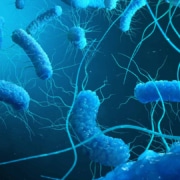Development of Nonpolar Liquid Antimicrobial Delivery Systems for Dry Sanitation
A sanitation program is a key component of a food processing facility’s food safety program and is a regulatory requirement for both FDA and USDA regulated products. Many sanitation programs utilize water and aqueous based sanitizers to control environmental pathogens. However, the introduction of water into facilities that manufacture low water activity, ready-to-eat foods could increase the potential for pathogen outgrowth and compromise the safety of the product. Instead, production of low-moisture foods (LMF) should utilize dry sanitation procedures to prevent pathogen contamination.
Pathogen control in the production of low water activity foods is difficult to accomplish with current dry sanitation products. Ethanol and isopropanol are commonly used sanitizers since they evaporate and leave no residue. However, they are highly flammable. Therefore, the use of these alcohol-based sanitizers requires the processing equipment to cool down prior to use, reducing the frequency of cleaning given the labor and time cost for processors.
As an alternative to alcohol-based sanitizers, organic acids in combination with non-polar liquids could be a viable option. Organic acids are commonly used as food additives or antimicrobials treatments to prevent the growth of pathogens. In hydrophobic environments, the antimicrobial activity of the organic acid can be increased due to a shift to a non-dissociated form. Therefore, utilizing non-polar liquids as a delivery agent for antimicrobial organic acids could be an effective sanitation strategy for dry processing environments.
This newly funded project aims to develop and validate non-polar liquid sanitizing formulations for food processing environment cleaning applications. This provides an alternative sanitizing tool that decreases the hazards associated with traditionally used alcohol-based sanitizers while increasing the frequency of sanitation and ultimately improving the safety of foods processed in dry environments.
Institution: University of Massachusetts, Amherst
Principal Investigator: Lynne McLandsborough, PhD
Year Awarded: 2023
Learn more about the IAFNS Food Microbiology Committee
Simulating Powdered Product Sampling to Improve Food Safety Sampling Plans
Drawing accurate conclusions about whether an ingredient or finished product is safe based on the results of a test is important to the evaluation and management of food safety risk. With the expected prevalence of contamination in today’s food system at less than 1%, extremely large samples sizes are required to reliably detect contamination, and the potential for false negatives during routine sampling is high. It is therefore critical that samples are representative of the ingredient or product being evaluated, and that sampling plans maximize the probability of finding a target hazard -- particularly as contamination patterns are often heterogeneous rather than uniform. This project will leverage a recently-developed bulk product simulation model to create a publicly available model used to detect low-prevalence, low-level contamination in powdered products and ingredients, such as powdered milk and cocoa powder.
Institution: University of Illinois at Urbana-Champaign
Principal Investigator: Matthew Stasiewicz, PhD
Year Awarded: 2021
Publication on Simulation Evaluation Of Power Of Sampling Plans
Access the interactive web app designed to run sampling simulation
- An extended tutorial/user video to utilize the app can be found here
View this project on the Center for Open Science’s Open Science Framework.
- This project was referenced in a Perspectives paper published in the Journal of Dairy Science.
Learn more about the IAFNS Food Microbiology Committee.
Sampling of Post-Hurricane Florence Floodwater for Human Foodborne Pathogens
Heavy rainfall and flooding following a hurricane can massively impact water quality, especially via runoff from agricultural and industrial operations. The IAFNS Food Microbiology Committee is supporting researchers at North Carolina State University to examine the emergence, potential routes of contamination and proliferation, as well as virulence and susceptibility of three major foodborne pathogens in the freshwater supply following Hurricane Florence: Salmonella, Listeria and Campylobacter.
These findings will be integrated with geospatial analysis and land use information. The choice of these pathogens was dictated by the significant threats that they pose to food safety and public health and their known capacity to survive and persist in fresh water. The data will provide assessments of pathogen prevalence during and post-flooding, as well as estimates of the time periods required for return to baseline levels. The learnings from this study will also support mitigation and control of pathogens in future food systems.
Institution: North Carolina State University
Principal Investigator: Sophia Kathariou, PhD
Year Awarded: 2018
Learn more about the IAFNS Food Microbiology Committee.
Simulating Large-Number Bulk-Product Sampling to Improve Food Safety Sampling Plans
Drawing an accurate conclusion about whether a food ingredient or product is safe based on the result of a test is important to the evaluation and management of food safety risk. It is critical that sampling plans maximize the probability of finding a target hazard in an ingredient or a finished product, particularly with non-uniform and low level contamination. Sample collection in bulk ingredients is typically done manually in the food industry, but manual sampling is time-consuming and laborious, and often results in sampling inconsistency. Therefore, a different approach is needed for rapid and efficient collection of representative samples of these products. The goal of this project is to build a validated and ready-to-use simulation model of bulk product sampling to improving sampling plans.
Institution: University of Illinois at Urbana-Champaign
Principal Investigator: Matthew Stasiewicz, PhD
Year Awarded: 2018
Access the bulk product simulation model
View instructional videos on how to use the model:
- Introduction to the Bulk Product Simulation Model
- Explanation of Inputs for 2D Simulation: Pathogens in a Produce Field
- Simulating Sampling for Pathogen Contamination in a Produce Field
- Explanation of Inputs for 3D Simulation: Mycotoxins in a Bulk Bin
- Simulating Sampling for Mycotoxin Contamination in a Bulk Bin
View this project on the Center for Open Science’s Open Science Framework.
Learn more about the IAFNS Food Microbiology Committee.
Survival and Inactivation of Bacterial and Viral Pathogens in Model Low-Moisture Foods
Low-moisture food (LMF) products are often ingredients (e.g. nuts, dried fruits, cereal products, and chocolate) used in the manufacture of many food products. Because of this, they carry significant potential for the amplification of outbreaks and recalls over a wide variety of products. There has been worldwide recognition of the need to more seriously manage the microbiological hazards associated with these products. The aim of this project is to understand the survival of pathogens (Salmonella spp., L. monocytogenes, and viruses) in the dry food manufacturing environment and in low water activity products.
Institution: University of Guelph
Principal Investigator: Jeffrey Farber, PhD
Co-Investigators: Sabah Bidawid, PhD, Nathalie Corneau, Neda Nasheri, PhD (Health Canada); Sophia Kathariou, PhD (North Carolina State University); Keith Warriner, PhD (University of Guelph)
Year Awarded: 2016
Learn more about the IAFNS Food Microbiology Committee.





